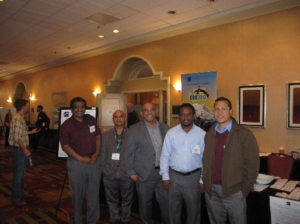 CARC Water Team members Ripendra Awal, Ram Ray, Haimanote Bayabil, Almoutaz El-Hassan, and Ali Fares actively participated and contributed to the 51st Annual Meeting of the South-Central Section, Geological Society of America, which was held from March 13-14, 2017 in San Antonio, Texas. The Water Team members gave four oral presentations during the meeting. Awal shared the results of the study on the Development of a new irrigation scheduling tool for agricultural crops and urban landscape in Texas.
CARC Water Team members Ripendra Awal, Ram Ray, Haimanote Bayabil, Almoutaz El-Hassan, and Ali Fares actively participated and contributed to the 51st Annual Meeting of the South-Central Section, Geological Society of America, which was held from March 13-14, 2017 in San Antonio, Texas. The Water Team members gave four oral presentations during the meeting. Awal shared the results of the study on the Development of a new irrigation scheduling tool for agricultural crops and urban landscape in Texas.
The specific objectives of this study were to: i) develop web applications to acquire near real-time weather data of rainfall and reference evapotranspiration from different weather networks across Texas, and ii) develop an irrigation scheduling tool to provide site specific near real-time irrigation scheduling data (when to irrigate and for how long to irrigate) for agricultural crops and urban landscape in Texas. The tool keeps track of crop growth stages starting from planting and the status of the different soil water budget components (crop evapotranspiration, soil water content, drainage) on a daily basis based on near-real time weather data, e.g. rainfall and potential evapotranspiration demand. This tool will help increase irrigation water use efficiency in agricultural crops and urban landscapes in Texas, eliminating over and under irrigation applications.
Ram Ray discussed the finding of a study on Assessing the effects of change in impervious areas on flooding in Texas. The goal of this study was to evaluate the effects of change in impervious surfaces on flood frequency at selected major watersheds (San Antonio, Colorado, Brazos, San Jacinto and Trinity) in Texas. Ray concluded that the highest rate of change in impervious area was at San Jacinto watershed between 2006 and 2011; as such 1.5% (105 km2) area of this watershed was changed into 50-100% impervious surface between 2006 – 2011 whereas the change at Trinity and Brazos watersheds were 0.49 and 0.13% respectively. Although the effects of change in impervious areas on flooding was not consistent across the state, the majority of watersheds showed an increasing trend of flooding with respect to increased impervious areas during the study period..
Assessing climate change effects on surface water resources in the lower basin watershed of the Colorado River was the topic of the presentation presented by Haimanote Bayabil. The objective of this study was to assess the effects of potential climate change scenarios on streamflow in the Lower Basin Watershed, one of the Colorado River Basin Watersheds in Texas based on 11 Global Circulation Models (GCMs). Overall, results of this study show that projected streamflow will greatly vary spatially and temporally. While all GCMs agreed in their predictions of minimum and maximum temperature, GCMs predictions of precipitation showed greater variability and contradictions at times. Overall predictions based on multi-model ensemble projections show that annual streamflow will decrease considerably towards the end of the 21st century.
Almoutaz Elhassan shared results of his work on Modeling the effect of landuse change on hydrologic response of a semi urbanized watershed using a physically based distributed model . He investigated the impacts of landuse change on surface runoff responses of the Leon Creek watershed, a 538 km2 sub-watershed within the San Antonio river basin, with a typical Texas Hill Country landscape. A physically based distributed model: Gridded Surface Subsurface Hydrologic Model (GSSHA) was used to simulate runoff from the watershed. Preliminary results of this work indicate that the landuse change has significantly altered the physical soil hydraulic properties (e.g., infiltration rates) that govern the hydrological processes in the watershed.
Haimanote Bayabil
Post-doctoral Researcher, Cooperative Agricultural Research Center
hkbayabil@pvamu.edu
(936) 261-5021

